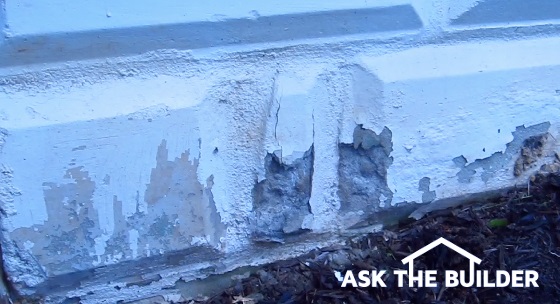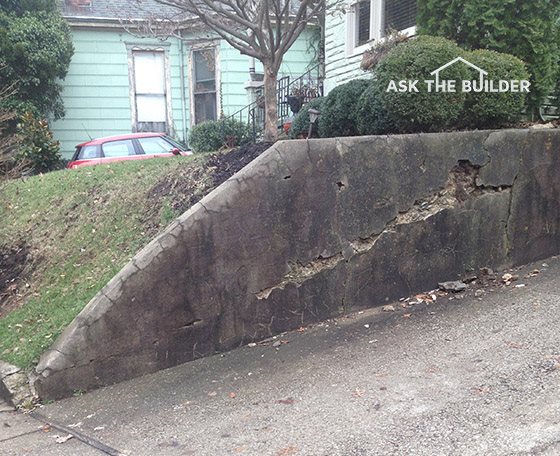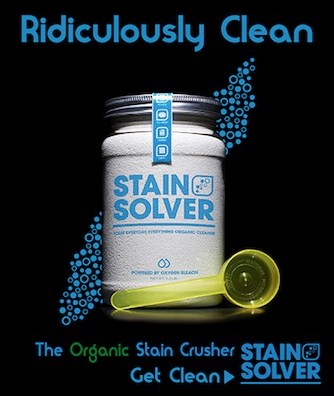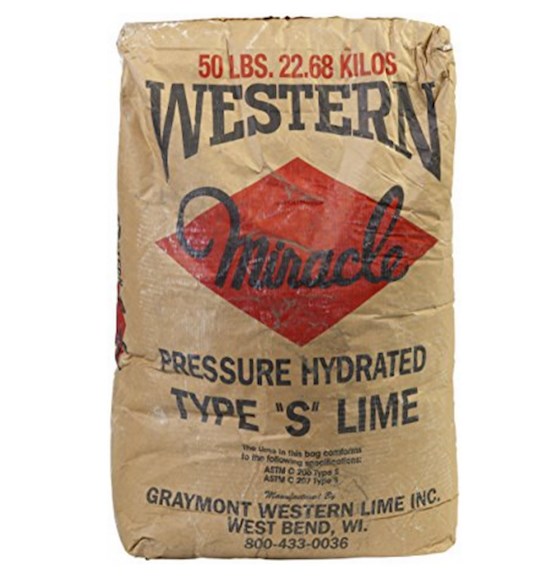How to Repair Stucco and Concrete Block

Repair Concrete Block | Here’s some older crumbling concrete block that resembles cut stone. The damage is superficial and can be repaired with ease. Great crumbling concrete foundation diy fix tips can be found on this page too. Photo Credit: Tim Carter (Bricks were white, but turned blue in the photo.)
Repair Concrete Block and Stucco Tips
- Remove algae with Stain Solver for best repair bond
- Use cement paint for best bond of repair mix
- WATCH my THREE VIDEOS BELOW!
- Fill deep holes in stages - install galvanized anchors
- CLICK HERE to Get Tim's FREE & FUNNY Newsletter!
DEAR TIM: I live in a house with a concrete block foundation. I think the outside of the block has a decorative stucco on it because the exterior of the block is not smooth. Some of the exterior is crumbling and I wonder if my foundation is going to fail. Can the damage be repaired? How do you get the stucco to stick onto the block and not fall off? Each time I’ve tried to do the job, the repair material falls to the ground. Help! Lynn L., Mt. Airy, MD
DEAR LYNN: If each of the concrete block looks similar with respect to the exterior pattern, I would say the block were made that way and it’s not a stucco coating. When concrete block were first brought to market, it didn’t take the block manufacturers long to realize they could make the outside of the block look fairly decent as if the block were fancy cut pieces of limestone or even granite.
How Can I See Foundation Block?
You can look at the inside of your foundation and see what kind of condition the block are on the side that faces your basement or crawlspace. Look for similar crumbling or cracks. If the inside of the block looks good, then I feel confident your problem is just a cosmetic defect in the block. The good news is this is very easy to repair.
Why Did Your Repair Fail?
Let’s discuss why your previous repair attempts failed. There list of reasons could be long, but we’ll just concentrate on the ones that are at the top of the list. When you decide to repair the vertical face of stucco, concrete block or even concrete, the surface needs to be clean, dust-free, and structurally sound. This means you need to remove any loose crumbling material to a depth by scraping with a stick that to remove more material you need a chisel and hammer.

Holes like this in a concrete, stucco or concrete block wall CAN BE PERMANENTLY repaired using the materials and tips I offer below. KEEP READING and WATCH the VIDEOS. © 2017 Tim Carter
Should the Repair Material Be Sticky?
The repair material you use must have enough cement and/or lime in it so that it’s sticky. Realize the Portland cement and lime you’ll sometimes find in mortar mixes or bagged concrete is the primary ingredient that makes the repair material bite or stick onto something else much like paint, glue or epoxy adheres to surfaces. If you don’t have enough cement or lime in your repair mix, it won’t stick well.
Is a Dry Mix an Issue?
Your mix may have been too dry and the concrete block sucked too much moisture from the mix too fast. This can also cause the repair material to not be as strong as it could be.
Will Repair Material Stick to Dirty Concrete?

Stain Solver is MADE in the USA with USA ingredients that are food-grade quality. CLICK THE IMAGE to order some NOW.
No, your new repair material will not stick to dirty concrete block or that covered with algae or mold.
I use Stain Solver, a certified organic oxygen bleach, to get mold, algae and other dirt from concrete block or stucco.
It's a powder you mix with hot tap water. Stir until dissolved and put into a hand-pump sprayer. Saturate the area to be cleaned working on an overcast day if possible. Keep the area very wet with the solution spraying more on every few minutes.
You'll see it foam and bubble if you look closely. Do not allow it to dry. Keep spraying.
Keep the masonry wet with the solution for at least 15 minutes. The longer you let it soak, the less you have to scrub. Scrub, rinse and make sure the old masonry is clean and free of dust and grit.
Should I Remove Loose Material?
Here’s how I’d repair your damaged stucco or the face of the concrete block. I prefer to make my own repair mix using just medium clean sand and pure Portland cement. Use hydrated lime in the mix because it really makes the repair mix sticky.

This is excellent hydrated lime. It's a fine white powder and it's going to look great on your home. CLICK THE IMAGE TO ORDER SOME RIGHT NOW.
What is the Primary Adhesive in the Repair Material?
Portland cement on it’s own, when mixed with sand, will create a repair material that can last hundreds of years. But adding hydrated mason's lime will make it even better. Click the above image to order the hydrated lime.
I prepare the concrete block by removing all loose material. Brush the block with a stiff brush. Washing the concrete block is also a good idea flooding it with water and scrubbing the area at the same time. You’ll want the block to be slightly damp when you start the repair, so washing it will not hurt the repair process.
Should I Install Pins In Deep Holes?
If there are deep holes to repair, the repair material will hold decades if you install downward angled long galvanized bolts into the hole. These are anchors, or posts, that the repair material will surround.
Have at least 2 inches of bolt showing so the repair material can really get a good grip. You can't have too many anchors.
Drive them in with a hammer or drill into the hole with a rotary hammer drill and drive the anchors, bolts or even short pieces of rebar into the holes. Get creative!
What is the Best Cement Sand Ratio?
The repair material should be mixed no less than two parts sand to one part Portland cement. For extreme strength and stickiness, you can mix one part sand to one part Portland cement.
If you're going to use hydrated lime as well, and I suggest you do, here's the mix I'd go with:
- 4 parts / measures medium washed sand
- 1.5 parts / measures of Portland cement
- 0.5 parts / measures of hydrated lime
You add enough water to make the repair mixture resemble whipped mashed potatoes or warm cake icing. This means the material is wet, has body and will easily hold onto the side of a trowel that’s held in a vertical position.
If the material droops, falls off the trowel or resembles a thick gravy that sloshes around in the bucket, you added too much water. Add more sand and cement in the proper amounts, stir and make the material thicker.
What is the Cement Paint Secret?
The magic trick most don’t know about is a bonding layer of cement paint. Cement paint was used by masons of old to help new stucco material bond to old stucco, concrete or concrete block. You make cement paint by just mixing Portland cement powder with clean cold water. Mix it to the consistency of regular paint.
With the cement block clean and slightly damp, take an old paint brush and paint the area to be repaired with this cement paint. Brush it on as you would paint, but not too thick.
IMPORTANT STEP: Only brush on as much cement paint as you can cover with the stucco repair mix in five or ten minutes. You NEVER want the cement paint to dry on the concrete block so avoid working with this in the direct sun, on windy days or whenever conditions are such it would dry rapidly.
What are the Best Application Tips?
Apply the stucco repair mix over the cement paint. Make sure it’s no thicker than one-half inch. If the area to be repaired is deeper or thicker than that, you may have to apply two, maybe three, coats of stucco. If you need to do this, be sure the first coat is left rough and resembles a tiny mountainous area so the final or next coat has plenty of surface area to bite into. Wait at least 24 hours to add a second coat.
For deep holes, refer to the tips above about the anchors, posts, or bolts you need to drive into the deep hole.
To create a smooth texture on the repair, use putty knives, or other small metal hand tools that will allow you to recreate the look of surrounding concrete block. Don’t try to texture the repair material immediately, as it may take ten or fifteen minutes for the stucco material to stiffen up allowing you to sculpt it with tools.
Stucco Repair Videos - WATCH ALL THREE
This column was referenced in the May 21, 2014 AsktheBuilder Newsletter, along with a quote from the Lord Of The Rings.
Column 1040
8 Responses to How to Repair Stucco and Concrete Block